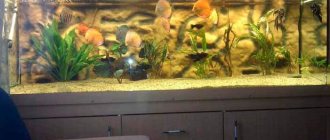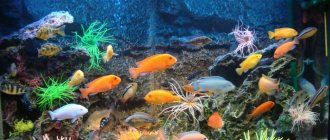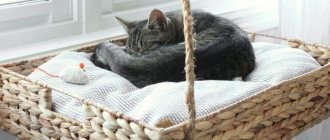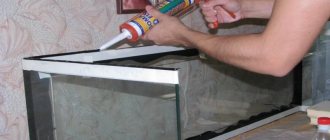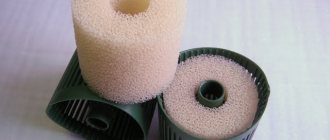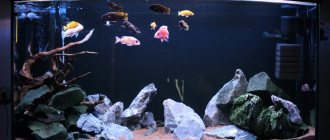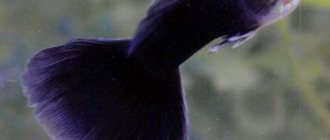At the same time, our grotto will not only be decorative, but will also become an excellent shelter for various types of catfish, and even a food source, for example, for ancistrus.
So, let's buy a coconut. We look first of all at its appearance - there should be no traces of mold. Shake the coconut - you should hear a characteristic gurgling sound inside. If the coconut does not gurgle, then it is probably spoiled and is not suitable for our purposes. The coconut is purchased, then the fun begins. There are as many options for the future of the grotto as your imagination allows. It can be a grotto with one entrance, or with several, located both at the ends and on the sides; both with straight holes and with asymmetrical holes.
We begin to “cut” the future grotto. To do this we need a drill, a hacksaw or a jigsaw and a knife. There are three spots on one end of the coconut - these are marks from the cutting. One of the spots does not have a hard shell and therefore breaks through easily. Using trial and error, we find it and pierce it with a knife. This is done in order to drain the coconut milk. There is one secret here: to make the milk flow out better and faster, drill another spot. The milk is drained, we use it for its intended purpose and move on. Using a hacksaw or jigsaw, we saw off the end on which there were stains - we get the future entrance to the grotto.
Now you need to clean the inner surface of the coconut from the pulp. To do this, take a knife and carefully, in small pieces, break off the pulp directly from the shell. We use the pulp for its intended purpose. The future grotto is ready. Next, you can use all your design skills and make, for example, a few more inputs and outputs with a jigsaw. The edges can be made uneven by breaking off pieces of the shell with pliers.
And finally, some tips. It is not necessary to remove the “hair” on the coconut (it’s a matter of personal taste); and if you have ancistrus, then in six months the coconut will be polished both outside and inside. If your aquarium is more than 100 liters, then it is not necessary to boil the coconut; in a smaller aquarium it can turn the water brownish, so boiling to remove the coloring pigment is recommended. The specific gravity of a coconut shell is greater than the specific gravity of water, so it sinks safely and does not require additional fastening. And also, as a decorative element, Java moss and anubias grow perfectly onto coconut shells - secure them only with a thin fishing line for the first time.
As you can see, making a coconut grotto is not a difficult process at all and can be done by anyone who wants to add variety to their underwater world.
Purpose and general requirements
A grotto is installed in an aquarium not only for decoration, but also to shelter the fish from aggressive neighbors. Another similar structure can be used as a shelter for growing fry and other small fish, and in such a house aquatic inhabitants can hide eggs.
Shelter for aquarium fish can be purchased at the store or made by yourself. People who want to make an underwater house themselves need to take into account that there are some requirements:
- the materials used should not contain lime, iron inclusions, chemical dyes and soluble elements (paper, fabric);
- the design should not have traumatic sharp corners and surfaces, too narrow cracks in which aquatic inhabitants can get stuck;
- Do not use wood containing a large amount of resin (oak, pine);
- It is prohibited to use stones from industrial areas to make decorative structures;
- Only silicone aquarium sealant is suitable for gluing parts of the grotto.
Wooden tower
You can also build a wonderful grotto for an aquarium with your own hands from driftwood or a small stump. The main thing is not to take oak, which tints the water and releases unnecessary phytoncides into it. And make sure that the material is not rotten. It is also a good idea to treat the workpiece with special agents that prevent rotting. The technology is elementary: in accordance with one’s ideas about beauty, but taking into account the size of the fish living in the aquarium, passages and halls are cut out inside the wood. All places that the knife touched are scorched with a candle or a blowtorch: this will give it a natural look and will become an additional insurance against injuries.
How to make a grotto for an aquarium with your own hands
When making a cozy shelter for aquarium fish, various natural and artificial materials can be used: stones, clay, wood, coconut, glass bottle.
Stones
From small stones that do not have sharp edges, you can make a frameless grotto. Initially, you need to boil the material, and then degrease it with acetone and sequentially glue the stones to each other, row by row, forming a small hemisphere with an open entrance.
To glue the materials together, it is recommended to use a plastic, colorless sealant. After gluing and drying, it is necessary to keep the product in replaceable water for 3 days. A grotto made of stones should be installed before filling the aquarium with water, since this requires gluing the first row of stones to the bottom glass of the tank.
Clay
A clay grotto is suitable for creating a beautiful aquarium design and a secluded home for fish. You can buy clay at a craft store. It is recommended to use white clay, because... it contains a minimum of unnecessary impurities. By adding water and stirring, you need to bring the composition to the consistency of plasticine and mold the resulting mass into a house of the desired shape.
After formation, the structure must be dried at room temperature for 6 days and fired in the oven. The firing time is 60 minutes; it is recommended to keep the oven door slightly open. The product must be heated gradually, from a minimum temperature of +200°C to a maximum of +300°C. The grotto also needs to be cooled slowly, reducing the firing temperature over half an hour. Only after the grotto has completely cooled can it be removed from the oven. Before loading into the aquarium, the fish house must be rinsed with water.
Tree
To make a wooden grotto, you need to take a massive piece of driftwood (so that it can be easily drowned) or a stump from a non-resinous tree. The bark should be removed and the outer surface sanded to prevent injury to the fish. Then you need to drill out the caves of the desired diameter and round the edges. To avoid damage to wood in water, it is recommended to burn the product with a blowtorch or gas burner.
To fix a wooden grotto, you need to tie it to a large stone or glue it to a glass surface using sealant.
Coconut
A coconut grotto is good and safe for fish. To make it, you need to purchase a fresh, ripe specimen. Initially, you need to open 3 holes located on the back side of the coconut palm fruit, and then drain the milky liquid. Then, using a hacksaw for metal, you need to saw off the back part and remove the pulp with a knife. Then the workpiece should be boiled several times for half an hour, washing it after each boiling. After this, using a stiff brush, you need to remove the remaining pulp and cut holes of the required size in the shell.
Before placing it in the aquarium, a homemade grotto should be soaked with changes of water until it stops coloring the liquid. After installing the decoration in the aquarium, it is recommended to pour soil into the shell (to make it heavier).
Glass bottle
A grotto made from a glass bottle is a good and budget option for decorating an aquarium. The volume of the container is selected depending on the size of the fish. First, the vessel must be washed well in hot water and the neck or bottom cut to the required size. For this purpose, you should soak a string in gasoline, wrap it tightly around the bottle in the right place and set it on fire. When the thread burns out, it is necessary to lower the vessel into a container with melt water. It will break off in the intended place. Finally, you need to sand the sharp edges with a fine file.
To improve the appearance of your homemade shelter, you can coat the surface of the bottle with aquarium glue and roll it in pebbles. Then you need to wait for the sealant to dry and, if desired, stick on decorative elements. Before placing it in the aquarium, the structure must be kept in replaceable water for 4 days.
Decorations made of pebbles
The easiest option is to make a grotto out of stones for your aquarium with your own hands. Flat river pebbles will do. You just need to glue the stones together in random order to make a small hemisphere. For convenience, you can put something underneath, for example, a toilet paper roll. It will act as a frame that will support the stones in the desired shape until the glue dries. This takes about a day.
The main difficulty here is that you need to glue the first layer of stones directly to the bottom of the aquarium, because the grotto must stand motionless under water, otherwise it will simply fall apart. If the stones are heavy enough, then you don’t have to do this. It should be taken into account that the bottom will still be covered with a layer of soil, so the entrance must either be located above the ground level, or be large enough for the fish to swim inside.
To be on the safe side, you can place the grotto in an aquarium without fish for several days, periodically changing the water. This will help flush out any remaining harmful substances from the materials and check the strength of the structure.
There is another way, but it requires the use of a drill. You will need a stone of a suitable size to drill a fish cave in it. The advantage of this option is that there is no need to glue it to the bottom; there is nothing there to fall apart even when moving. But there are also disadvantages - you need minimal skills in working with drills, a correctly selected stone (not only in size, but also in material, because not everyone can be drilled just like that) and a lot of patience. There will be a lot of noise and dust during operation.
Choosing a grotto depending on the fish
The choice of a grotto for an aquarium depends on the types of fish, since different types of aquatic inhabitants have different preferences regarding the places in which they are ready to live. Recommendations for choosing a shelter:
- Catfish need a wooden niche or large piece of driftwood to hide under. It is recommended to take branches or roots of linden, pear, apple or grapevine. They should be wide and form something like a quiet backwater, so that adult individuals lay eggs in it, and then the offspring will grow there. In addition, moving along the trunk, the catfish collects particles that improve its digestion.
- For viviparous fish (swordtails, guppies and mollies) wide houses with small entrances are needed. In them, females can calmly reproduce and raise offspring. A good shelter option is coconut halves, a grotto in the shape of a ship with a wide and hollow deck, or a cave.
- Labyrinth fish (lalius, cockerels, gouramis) during the period of preparation for offspring become too aggressive and attack everyone who approaches their home. Therefore, to separate family and neighbors, you need to install several grottoes in the aquarium, and the shapes and sizes of the structure should be different.
- For goldfish that grow to large sizes and love to spin around in numerous holes and structures, a flat castle with wide and varied arches is best suited. A good option would be arches glued together from small stones.
Important! It is worth considering that the grotto should not occupy more than 30% of the space in the aquarium.
Purpose of a decorative grotto
In fact, each aquarist independently determines what the landscape of his aquarium will be like. At the same time, experts are confident that it is advisable to equip a grotto if the aquarium contains restless pets that constantly chase each other. In this case, this device will act as a refuge from aggressive inhabitants of the aquarium.
Did you know? The smallest aquarium in the world is only 3 cm long and only 15 mm wide.
In addition, a beautiful grotto will only decorate the aquarium landscape. Therefore, this element is actively used in many areas of aquascape.
Decorative grottoes for home ponds can be purchased in specialized stores. However, most aquarists prefer self-made decorative elements. And this is explained simply: they try to make jewelry according to their own design and taste.
Find out how to choose the necessary items for an aquarium: lamp, external and internal filter, heater, background; and also how to make an external filter and an ultraviolet lamp with your own hands, how to install a lamp in an aquarium and start the aquarium for the first time.
Care
After placing the shelter in the aquarium, it is necessary to care for it. It is recommended to clean the water house from waste once a month and remove dirt from the soil under the decorative structure with a siphon. To properly clean the grotto, it will be enough to immerse it in hot water for a while. Experts do not recommend using household chemicals to wash the structure, since there is a high risk of poisoning aquatic life with chemicals.
If you liked the article, leave comments and share a link to it on social networks.
Clay crafts
If possible, you can make a grotto from red clay. This method is the most labor-intensive of all, because the clay must be fired, otherwise the product will simply break.
So, first you need to build a cave of a suitable shape. For example, in the form of a pot with a broken side or just a rectangular house. To make it spherical, you can use a balloon: inflate it to the desired size, cover it with a layer of clay (not too thin), let it dry and carefully deflate the ball, being careful not to crumple the edges of the clay sphere.
Then the product must be dried. This can be done in the sun or in the microwave. After this, firing is required. If there is a workshop with a muffle furnace nearby, then you can go there. If not, then you will have to use an oven preheated to 220 degrees. It is better to leave the door ajar. Firing takes about an hour, after which the temperature gradually decreases over 15-20 minutes . If you turn off the oven immediately, the clay will become brittle.
After firing, you can place the product next to the fish. If you decide to paint it, you need to make sure that the paints are non-toxic and will not poison the water. It is advisable to additionally burn purchased shards to kill microbes.
The clay grotto is the most labor-intensive of all, because the clay must be fired, otherwise the product will simply break.
Wooden grotto
The simplest option is a stump, in which holes are drilled of the size and location required according to your own design. Naturally, a stump or stump is selected without signs of rotting or decomposition, and it is cleared of bark.
The holes and all other necessary places are polished to prevent injury to the fish. To prevent rotting in aquarium water, the piece of wood should be burned with a blowtorch or gas burner. Read more about how to process wood in this article.
For such a natural grotto, you need a base, which is sprinkled with soil in the aquarium. By the way, you can glue a piece of wood directly to the bottom of the “can.” As a result of the work done, a grotto is obtained, combined with driftwood, and such a natural element of the landscape looks quite organic.
Aquarium design: photos, video examples, styles and options
AQUARIUM DESIGN Decorating an aquarium is a worthy and fertile topic for conversation. This is not surprising, because this is the primary question that people who have just bought an aquarium ask themselves. Unfortunately, this issue is surprisingly poorly covered on the Internet, briefly or fragmentarily. We hope this article will reveal all the aspects and nuances of aquarium design and help you create your own aquarium kingdom. Due to the volume of this issue, let's divide the article into two sections: 1. MATERIALS REQUIRED FOR AQUARIUM DESIGN: soil, stones, grottoes, driftwood, background, artificial and live aquarium plants, aquarium lighting, shells, castles, ships. 2. MAIN DIRECTIONS, TYPES AND EXAMPLES OF DESIGN OF AQUARIUMS.
Materials necessary for decorating an aquarium
And so, as you know, in order for fish to appear in your house, you need a vessel and water. However, aquarium keeping is not just the banal keeping of fish, it is the creation of a closed ecosystem, imitation of the natural conditions for keeping aquatic organisms. It’s trite, but aquarium science begins with fish. Before you think about decorating an aquarium, first of all you need to decide on your desires and the fish that will swim in your pond. And this is very important! Each individual fish needs its own conditions of detention, its own water parameters, and other conditions. And it is precisely for them that an “aquarium house” needs to be built, this is precisely what we need to start from. For example, if you decide to keep African cichlids and at the same time want to see a garden of living aquarium plants in your aquarium... You are initially dooming yourself to a virtually impossible task. The natural habitat of most African cichlids is the rocky banks of the river. Nyasa and r. Tanganika, there are no plants, no algae - this is a “stone desert”. If you place plants in an aquarium with cichlids, they will pull them out and destroy them. Based on what has been said, we advise you to first decide on the fish that will live in your aquarium, study their characteristics and habits, read and find out the conditions for keeping them. And then start and think about decorating the aquarium. DECORATING AN AQUARIUM WITH SOIL Soil is one of the most important elements of an aquarium, it is its mood. It is very important to approach the issue of its choice with special attention, because in addition to decorative functions, the soil plays the role of: a substrate for plants, for spawning and the life of fish. It is important to choose the right fraction of soil, it is important to choose the required volume of soil, and only then the color of the soil. There is a good article on our website about the selection and selection of soil, we suggest you read it HERE.
Speaking about the decorative properties of the soil, it is recommended to choose a soil of darker tones, so that the bright and light colors of the aquarium bottom do not overshadow the charm and beauty of the “main heroes of the occasion” - the fish. DESIGNING THE AQUARIUM WITH STONES AND GROTTOES. An important technical nuance when decorating an aquarium with stones, grottoes, caves, etc. is the use of non-toxic, non-toxic materials. If stones and driftwood are selected and made independently, you need to do everything according to the rules and make sure that they do not release harmful substances into the water. Certainly the decorations should not be made of limestone, rubber and metal, no paints or enamels!!! Speaking about the aesthetic part of the design of the reservoir, you should always remember that stones, grottoes, and driftwood take away the “usable area” of the aquarium - the living space. The amount of such decor is calculated based on the volume of the aquarium and the needs of the fish themselves. In addition, it should be taken into account that large decorative elements are installed along the edges of the aquarium or in the background. Don't put a huge castle in the middle!!! This is the equivalent of people putting the refrigerator in the middle of the kitchen instead of in the corner. An aquarium is an amphitheater of life! DESIGNING AN AQUARIUM WITH A BACKGROUND. The background of the aquarium is not so important for the aquarium inhabitants themselves. In fact, fish can live without it. The background is more important for a person; one might say, these are “aquarium curtains”, which play more of an aesthetic role than a technical one. For information on what types of aquarium backgrounds there are, how to make and attach them, see HERE.
DECORATING THE AQUARIUM WITH LIVE AND ARTIFICIAL PLANTS. Continuing to use metaphors, we can say that if the background of the aquarium is “curtains,” then the plants are “indoor flowers on the windowsill.” What they will be like and how many there will be will determine how your aquarium “window” will look. We recommend looking at a wonderful article on this topic – HERE. AQUARIUM LIGHT DESIGN
The power and spectrum of light is important for aquarium plants - this is their source of life.
When it comes to decorating an aquarium, the color of the light is important. Today there is a huge variety of colors for aquarium lamps. Choose according to your taste! Moreover, there are various bottom aquarium lights in the form of volcanoes, lanterns and LED aerators. Here they are.
DESIGNING THE AQUARIUM WITH ANOTHER DECOR. Aquariums can be decorated with shells, castles, ships, diver figures, skulls, etc. At the same time, it is not necessary to buy all this at a pet store at an exorbitant price. When using such decorations, you need to adhere to only two rules: non-toxicity and safety. The shells should not be sharp, and the figures of divers should not be made of rubber. See also the article Seashells in an aquarium. MAIN DIRECTIONS, TYPES AND EXAMPLES OF DESIGN OF AQUARIUMS The classic design options for an aquarium for fish are: Biotope - such an aquarium is designed to match the specific water landscape of a lake or stream. Dutch is an aquarium in which the main place is given to plants. Such an aquarium is popularly called a “herbalist”. The most famous Dutch aquariums are created by mega-aquarist Takashi Amano, here are his works: Geographic - such an aquarium is designed for a specific region, it contains fish only from this region. In the vastness of our Motherland, you can most often find a “household aquarium” - where the above principles are not observed. In such aquariums you can often find castles, amphorae, divers, skulls, etc., etc., etc. In addition, there is a whole industry of children's aquariums . Here's an example:
There are other directions in aquarium design. As they say, how many people have so many opinions. Next, let's clearly see the design options for an aquarium. Pseudo-sea aquariums. Such aquariums are designed and imitate marine aquariums - the seabed. The prefix “pseudo” indicates that such a reservoir does not contain sea fish. Only the surroundings are created! As a rule, brightly colored fish are selected for such an aquarium, which are often characteristic of cichlids, for example, elow, demanosi, parrots, etc. The aquarium itself is decorated with corals, artificial polyps and sea shells.
We wish you success in designing and creating your own individual aquarium kingdom; below are additionally presented photos that clearly show all the diversity and flight of aquarium thought in the issue covered.
Video about decorating an aquarium
fanfishka.ru>
Other simple options
Perhaps the easiest way is to make a cave out of coconut. You need to buy a fresh fruit, drain the milk from it, clean out the pulp and make entrances. You can leave the hairs. It is advisable to boil the new house.
Another simple way is to take a plastic bottle, cut off the neck, coat it with aquarium glue and roll it in sand or pebbles. Particular attention should be paid to the edges. To make it stable, you need to glue heavy pebbles around the edges or pour some directly inside. This option is especially good when you need to make a house in a hurry. However, you should remember that the glue must dry completely before immersing the craft in water.
Thus, making aquarium grottoes with your own hands is not at all difficult. It is only important to find environmentally friendly materials and use your imagination.
Necessary requirements for materials
A cozy refuge for fish can be made from a variety of materials: glass, stones, plastic, ceramics, wood.
If you decide to make your own decorations, then a number of necessary conditions must be met, the first of which is the principle of “do no harm.” This means that the “building material” should not be aggressive towards the aquatic aquarium environment and its inhabitants.
- For example, stones should not contain lime, which increases the acidity and hardness of water.
- You should not use material with a high iron content, the excess of which provokes the growth of green algae.
- It is also not recommended to take stones for an aquarium from areas of industrial quarries and enterprises.
A homemade decorative design is unthinkable without gluing materials.
Experts strongly recommend using exclusively special silicone sealant for aquariums. And nothing more.
- Decorative elements should not contribute to injury to ornamental fish. The use of materials with sharp edges and corners is not allowed.
- The wooden parts of the structure should also be treated with care and attention. Some types of wood can release unwanted substances into the water. This applies to tree species with a high resin content.
Once the necessary requirements have been determined, you can proceed to consider examples of making grottoes with your own hands.
Shopping is a joy
Today, pet stores and Internet sites offer a variety of artificial grottoes. The buyer will find them for any aquarium, ranging in size from 5 cm to a meter. A wide selection of shapes, colors and materials are available.
The decor in the aquarium is selected according to the designer’s idea or following an instant impulse. The first places come out to be ships and chests, usually associated with pirates and shipwrecks. I add mystery to the castles and towers, and the skulls have a slightly darker style. Not only fish can hide in these grottoes, but also compressors and filters can be disguised.
Options that are close to natural shelters: rocks, branches, corals, heaps of pebbles will help create the effect of a sea or river bottom. Especially if you plant algae correctly and decorate the glass bottom.
The leading position is occupied by grottoes made of ceramics, which are heavy enough to stand on the bottom, non-toxic and durable.
Separately, there is an artificial grotto made of plastic and plastic. Scientists have proven that they contain harmful additives that poison the water and cause illness in fish. Therefore, you should carefully read the composition and recommendations on the product description. Such decorations are often made for completely artificial aquariums, in which even the fish are plastic.
Finished goods
Decorations are chosen differently: according to shape, size, color scheme. When selecting, you need to take into account that a small grotto will get lost in a large aquarium, so the size must be appropriate. Most offers from specialized outlets include clay options, which have many advantages.
However, we must not forget about the forms. There are several that are most popular among consumers. Among them are a grotto-ship, a grotto-castle, a grotto-rock and a grotto-skull.
A ship-shaped grotto can often be seen among aquarists. It usually looks like a sunken pirate ship that has broken into several pieces. Most often there are quite a lot of compartments where fish can hide. In addition, it is in it that you can hide the sprayer from the air compressor, which often negatively affects the appearance of the composition.
The grotto in the form of an underwater castle looks simply fabulous. It seems that the aquarium houses a real marine kingdom.
The grotto rock is intended for those who love naturalness. Aquarists often place live plants next to it, and the grotto
looks like part of the natural landscape.
And finally, lovers of unusual and mysterious decor will love the skull-shaped grottoes. Some people prefer to throw a few coins, pre-coated with waterproof varnish, to the bottom. They will help create a brighter ambience and decorate the composition.
From clay
When the desired shape is formed, the mainsail needs to be dried. The process takes from 3 days to a week. If the product is wet, it will crack during firing. When working at home, an oven is used for firing, which is gradually heated to approximately 250 degrees. There is no need to rush in such a situation. Firing time – up to 6 hours.
Cooling the mainsail quickly is also not recommended. First it must cool in the oven, after which it is removed, rinsed with water and placed in the aquarium
.
